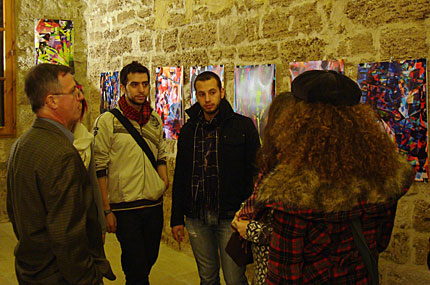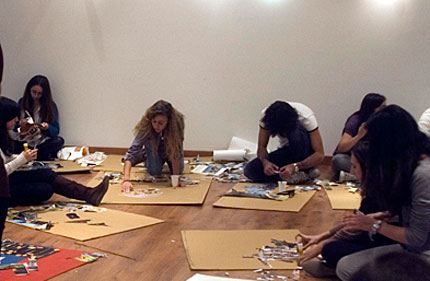Weeklong design conference concludes in Byblos (Update)
An exhibition featuring the works of two renowned designers from Japan and the Netherlands was held in the Byblos Souk following lectures at LAU.
![[photo]](design-exchange09-08-180.jpg)
The works of Bob van Dijk and Hiroki Yamamoto are on display in two separate rooms in the Byblos Souk.
![[photo]](design-exchange09-09-180.jpg)
van Dijk answers questions about his work during the exhibition opening Wednesday night.
Click on any photo above to view all nine photos of different Design Exchange '09 activities.
Graphic design students flooded the old Souk of Byblos on November 25 for the opening of an exhibition featuring the works of renowned designers Bob van Dijk from the Netherlands and Hiroki Yamamoto from Japan who each gave lectures earlier that day as part of LAU’s weeklong Design Exchange ‘09 conference.
The designers were present at the exhibition, which remained open daily from 10:00 a.m.-10:00 p.m. until November 28. They mingled with students while describing the inspiration behind each work, many of which were drawn by hand.
“I’m a big fan of the computer because I use it all the time, but sometimes sketching is very good because you can easily make a decision,” said van Dijk, who also expressed his love for painting.
The colorful works were all designed using a variety of techniques and instruments from computers to crayons.
Many of those techniques were illustrated by van Dijk and Yamamoto during the lectures several hours earlier at LAU Byblos.
During the first lecture, van Dijk, who works with design firm NLXL in The Hague, took the audience through a tour of some of his most recent projects for small and large companies.
One of the main tasks of his work, he said, was developing a fitting identity for each of his clients that catered to their needs.
“In a dynamic world with dynamic organizations, we need dynamic identities,” van Dijk said, explaining that the job was more about developing creative strategy than it was about simply designing attractive logos.
“We can all make nice things,” he added, “but the strategy behind it is more fascinating — it’s about trying to find the essence of a problem that a client has, and trying to solve that in a creative way.”
Yamamoto opened his lecture by giving a brief history of graphic art beginning with the 32,000-year-old Lascaux cave drawings in France, and the development of the alphabet.
He placed special emphasis on the importance of a medium or instrument used to create graphic art, whether it is a rock to make a carving from wood, or a paintbrush to create an image. Without them, he argued, graphic expression would bear no meaning.
“There’s a fine line between calling something graphic art, and not calling it graphic art, and it has to do with the medium that is being used to transfer it,” Yamamoto said. “It’s the medium that gives it value.”
 Visitors gather in the room where the works of Japanese designer Hiroki Yamamoto are showcased.
Visitors gather in the room where the works of Japanese designer Hiroki Yamamoto are showcased.
Updated November 25, 2009—
Now in its third day, the weeklong Design Exchange ‘09 conference on the Byblos campus is already a success with students, guest speakers and organizers alike.
The first two days included student workshop sessions by Bob van Dijk, a partner and designer at the design firm NLXL in The Hague, Netherlands, and Hiroki Yamamoto, a Japanese designer and president of Marvin design firm in Tokyo. Richard Doubleday, assistant professor of art at Boston University, who was also scheduled to hold workshops and a public lecture had to cancel at the last minute.
Monday and Tuesday, van Dijk presented the first two sessions of his workshop on “5 Ways of Being Creative,” which will be completed with a third session tomorrow.
The award-winning designer has lectured, presented workshops and exhibited in Europe, the United States and the Middle East.
He says he is really enjoying his workshop sessions as well as his time in Lebanon.
The workshop participants are “very enthusiastic,” van Dijk says. “They are curious, pose good questions, and are really interested in learning, and I can feel that they are already learning from the first assignment,” he adds.
The total number of registered participants for the different student workshops is about 75 people, including a little over 20 students per workshop as well as people just sitting in.
“The good thing about the fact that it’s a small group is that I can speak with the people in general but also individually,” says van Dijk.
He chose to have five small projects in his workshop, rather than one, so that students can “carry over what they learned [in one project] to the next one.”
One project was to create a ghetto blaster for the deaf, a contradictory concept. Patricia Farah, a third-year graphic design student from LAU Byblos, thought of the ghetto blaster in terms of invasion of space rather than sound. She created a concept of balloons that rhythmically inflate and deflate, becoming so big that they would intrude into the space of passers-by, including the deaf.
Along with the other participants, Farah was enthusiastic about the opportunity to attend the workshops. Comparing her mind to many closed doors before the workshop, Farah says van Dijk “had the key and opened the creative door.” She adds: “In his class the sky is the limit.”
Students “really have to get out of their box,” explains van Dijk. “That’s why, I tell them ‘never trust your teacher.’ ” This does not mean “they should not have respect for their teacher … [but] if they have a different opinion about things, [they should] start to communicate and see how far the two can learn from each other,” van Dijk adds.
The first session of Yamamoto’s workshop, titled “Construction From Deconstruction,” was held Monday, and will continue tomorrow.
The workshop involved collage and montage. Students spread out pre-existing designs in a workspace and deconstructed them. Later, they constructed new designs from the pieces.
 Students create new designs using collage and montage during Yamamoto’s workshop. (Photo: LAU graphic design student Patrick Makhoul).
Students create new designs using collage and montage during Yamamoto’s workshop. (Photo: LAU graphic design student Patrick Makhoul).
The views of organizers
Through such workshops, LAU’s Graphic Design Department in Byblos wants to expose students to the work and ideas of professionals from different countries, explain event organizers Tarek Khoury, department co-chair and assistant professor, and Melissa Plourde Khoury, assistant professor of graphic design.
As faculty members, “we offer students our own experiences and knowledge but by bringing people in from the outside who are not professors but … [professionals] and within a completely different culture, [we expose students to what] they bring with them — fresh ideas, a fresh vision, new insight [and] a different way of working,” Plourde Khoury says.
“We are taking action to involve the community and enrich our students. We’re trying to move the program into the future,” she adds.
Khoury explains that the event is called “Design Exchange” because it is about exchange of cultural identity. The goal is to have students take ideas from other cultures and integrate them into the graphic design field in Lebanon.
Today’s program includes public lectures by van Dijk and Yamamoto at the Science Building rooms 607 and 608, as well as the exhibition opening in the Old City of Byblos at 6:30 p.m.
Posted November 23, 2009—
Design Exchange ‘09, a weeklong graphic design conference featuring exhibitions, lectures and workshops led by three world-renowned graphic designers and design educators from Japan, the Netherlands and the United States, kicked off today at LAU Byblos.
The event, the first of its kind organized by LAU’s Graphic Design Department in Byblos, will last through November 28, followed by a student exhibition from November 30-December 4 in the Rima Hourani Exhibition Room on the Byblos campus.
Workshops will be held each day of the conference, excluding November 25, by Richard Doubleday, assistant professor of art at Boston University, Hiroki Yamamoto, a Japanese designer and president of Marvin design firm in Tokyo, and Bob van Dijk, a partner and designer at the design firm NLXL in The Hague, Netherlands.
On November 25, each of the three guests will present an hour-long lecture, followed by the opening of an exhibition from 6:30-9:30 p.m. in the Souk of the Old City of Byblos, where the invited presenters will display and be available to discuss their works.
The exhibit, held in coordination with Eddé Yard, will remain open daily (10:00 a.m.-10:00 p.m.) until November 28.
The workshops will be open only to graphic design students from LAU and the Scientific College of Design in Oman who must register before attending. The lectures and exhibitions will be open to everyone.
Organizers are promising the event will embrace the distinctions of design practice influenced by Far Eastern, Middle Eastern and Western cultures, while placing an emphasis on enhancing visual culture through modernization.
For a full schedule of events, information about registering for workshops, or for more details about the lectures and exhibition, visit the conference website, or contact Tarek Khoury, co-chairperson of the Graphic Design Department at LAU Byblos at: tarek.khoury@lau.edu.lb or +961-9-547254 ext. 2243.
More
Latest Stories
- LAU’s Think Tank Addresses Energy Transition
- Dr. Myriam El Khoury-Malhame’s Research Shapes a Resilient Future
- Future Pharmacists Take Their First Step into the Profession
- Breastfeeding Support Room Inaugurated at LAU
- LAU GASC Launches the Advisory Taskforce for Recovery, Reforms, and Development
- Engineers and Researchers Flock to LAU for the Fifth IEEE MENACOMM 2025
- Medical School Faculty Receives a Programme Hubert Curien–CEDRE Grant
- Dr. Yasmine Nachabe Taan on Arab Design Education


![[photo]](design-exchange09-10-big.jpg)
![[photo]](design-exchange09-03-big.jpg)
![[photo]](design-exchange09-04-big.jpg)
![[photo]](design-exchange09-05-big.jpg)
![[photo]](design-exchange09-02-big.jpg)
![[photo]](design-exchange09-06-big.jpg)
![[photo]](design-exchange09-07-big.jpg)